Digital transformation has become widespread across organizations in the past decade as they shift from traditional processes and systems to innovative cloud technologies.
However, a key component often missing in digital transformation efforts is a consistent and focused effort to help employees adopt software improvements.
Without this capability, technological investments risk becoming futile, potentially exacerbating employee fatigue related to constant change.
Digital dexterity focuses on the ability of employees or an entire workforce to quickly adapt to and effectively utilize new software applications or technologies to enhance efficiency and achieve goals.
A digital dexterity framework equips employees with performance support and upskilling initiatives, enabling them to utilize new digital tools effectively.
Once you have read this guide, you will know:
- What a digital dexterity framework is & why it is so important
- The critical digital dexterity qualities that an organization should strive for
- Which teams are responsible for developing a digital dexterity framework
- How you can implement a digital dexterity framework within the workforce
- The benefits of a digital dexterity framework
- Why some businesses lack digital dexterity
- What Is A Digital Dexterity Framework And Why Is It Important?
- Key Digital Dexterity Qualities
- Which Team is Responsible for Developing a Digital Dexterity Framework?
- Implementing A Digital Dexterity Framework Within The Workforce
- Benefits of Digital Dexterity Framework
- Why Do Some Businesses Lack Digital Dexterity?
- Start Building A Digital Dexterity Framework For Your Employees
What Is A Digital Dexterity Framework And Why Is It Important?
A digital dexterity framework is a plan that focuses on equipping employees with the necessary digital skills and capabilities to thrive in the future workplace.
This framework helps an organization fully leverage new and existing digital technologies by focusing on what training employees need to use these tools within their day-to-day roles.
Employees proficient in digital skills are more adept at streamlining business processes, allowing them to focus their valuable time on tasks that require human intelligence.
While every employee must have the right skills to use the digital tools required for an organization, many digital transformation strategies do not focus on this type of upskilling. Instead, organizations spend a lot of time accumulating a wide range of the latest tech tools or strictly following IT-driven directives without implementing change management initiatives.
As a result, these transformations fail as the relevant strategies miss out on equipping employees with relevant digital skills, making it easier for them to adopt new digital tools and processes.
Now that you know what a digital dexterity framework is, let’s understand the key digital dexterity qualities that organizations need to ensure their employees possess.
Key Digital Dexterity Qualities
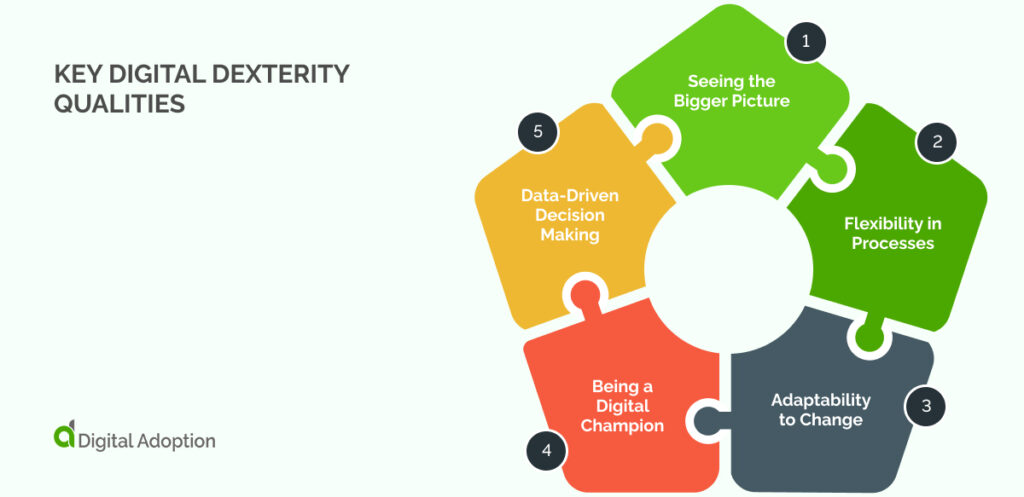
For companies undergoing digital transformation, cultivating digital dexterity is essential.
To effectively achieve this skill set, companies must recognize and nurture specific characteristics within their workforce through its digital dexterity framework.
The main qualities include:
Seeing the Bigger Picture
Employees who proactively envision and develop solutions and processes that support and facilitate growth are invaluable. Such a mindset is crucial for building digital dexterity, as it ensures that the organization can adapt and expand its digital capabilities in line with its growth.
Flexibility in Processes
Understanding that processes constantly evolve and that new tools can drive innovation is fundamental to digital dexterity. Employees who embrace this concept contribute significantly to a continuous improvement and innovation culture.
Adaptability to Change
A willingness to embrace change and adapt to new processes and technologies is a cornerstone of digital dexterity. Adaptable employees are more likely to navigate the challenges and opportunities digital transformation presents successfully.
Being a Digital Champion
Individuals constantly exploring new ways to leverage digital tools for process improvement are vital. These ‘digital champions’ often lead the way in adopting and integrating new technologies into everyday workflows.
Data-Driven Decision Making
Adopting data to lead decisions is critical to digital dexterity. Employees adept at analyzing and applying data insights can compel more effective strategies and solutions, leading to a better organizational transformation.
Fostering these qualities within the workforce positions an organization to successfully navigate its digital transformation journey, ensuring it remains competitive and resilient in an increasingly digital world.
Which Team is Responsible for Developing a Digital Dexterity Framework?
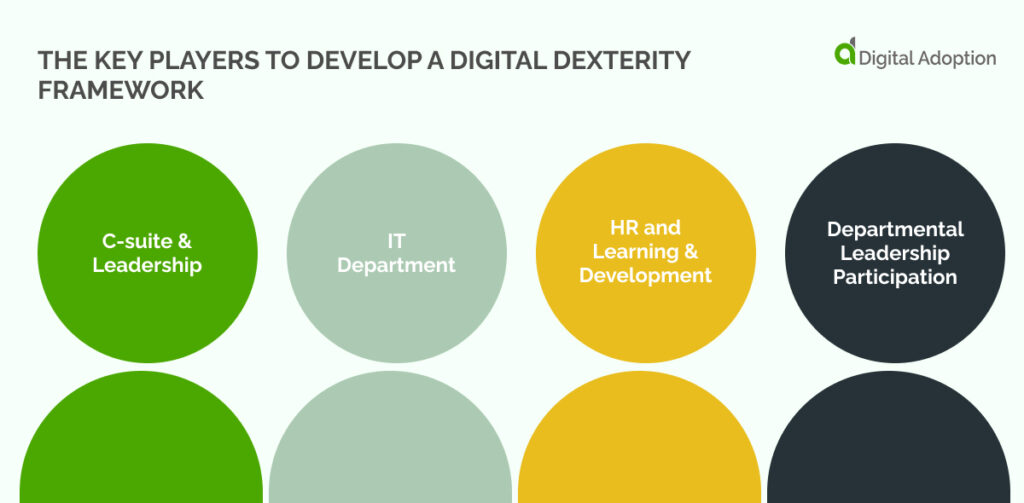
Multiple departments are involved in the journey towards digital transformation and enhancing digital dexterity.
To effectively improve digital dexterity, it’s essential to form a cross-functional task force encompassing various levels of expertise and seniority aimed at dismantling silos within the organization.
Here are the leading players necessary for initiating a digital dexterity framework:
C-suite & Leadership
The digital dexterity initiative must be driven from the top. C-suite executives and leadership teams must fully endorse digital dexterity, setting an example for the organization. They play a critical role in demonstrating the benefits and ROI of digital dexterity, thereby cultivating an environment conducive to digital transformation.
IT Department
IT professionals are vital for developing software requirements, crafting technology roadmaps, and formulating implementation plans. They are also responsible for monitoring the adoption rates of new digital tools, ensuring they align with the organization’s objectives.
HR and Learning & Development
The Human Resources and Learning & Development departments create training content and courses focused on onboarding new applications and reskilling and upskilling employees to build their digital dexterity. This is crucial for ensuring all employees have the skills to navigate the digital landscape.
Departmental Leadership Participation
Leaders from various departments should actively participate, bringing unique insights and requirements from their respective areas. Their involvement ensures that the digital dexterity initiatives are relevant and cater to the specific needs of different parts of the organization.
This collaborative approach ensures that digital dexterity becomes an integral part of the organizational fabric, encompassing various perspectives and expertise, thereby making the digital transformation more effective and inclusive.
Implementing A Digital Dexterity Framework Within The Workforce
Developing digital dexterity is crucial for organizations to ensure a return on investment (ROI) in digital technologies.
With the skills to use software applications effectively, these investments can avoid missing ROI and encountering severe issues like inaccurate data, non-compliance with laws, and failure to meet objectives.
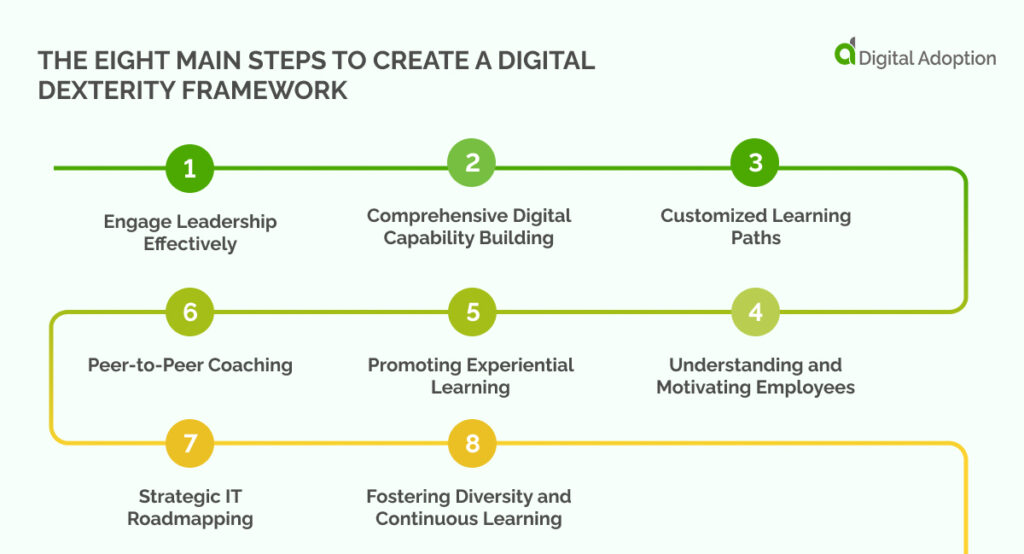
Here are eight critical practices to create a digital dexterity framework for your workplace:
- Engage Leadership Effectively
Leaders play an important role in shaping a digital-first culture. They should be aware of emerging digital threats and opportunities and actively demonstrate how to counter these challenges using digital tools.
By modeling digitally dexterous behaviors, leaders can inspire their teams to acquire similar skills and foster a collaborative environment where digital tool utilization is a priority.
- Comprehensive Digital Capability Building
Every role, from office-based to fieldwork, requires digital competency.
Essential skills like effective collaboration through digital platforms, understanding and leveraging data, managing digital workflows, and efficiently accessing and creating information are fundamental. This comprehensive capability building ensures a uniformly digitally mature enterprise.
- Customized Learning Paths
Employees have varied levels of familiarity and comfort with digital tools. Assessing these differences and creating learning programs tailored to different groups is important.
Segmenting the workforce and designing specific training modules helps address individual needs effectively. Linking progress in digital skills to tangible rewards or recognition can further motivate employees.
- Understanding and Motivating Employees
Not all employees may initially see the value in digital upskilling. Communicating the business benefits and how these skills can contribute to their personal and professional development is crucial.
Regular check-ins, surveys, and open dialogues can help understand employee perspectives and tailor the approach to digital education.
- Promoting Experiential Learning
Theoretical knowledge of digital tools is not enough; practical application is vital. Facilitating opportunities where employees can apply new digital skills in real-world scenarios is crucial.
This could involve working on specific projects, shadowing digitally proficient colleagues, or engaging in cross-departmental collaborations.
- Peer-to-Peer Coaching
Identify employees who show a keen interest in learning and teaching digital skills. These individuals can act as in-house coaches, spreading digital competencies within their immediate network.
This peer-to-peer learning approach can be more relatable and compelling as it comes from colleagues who understand their peers’ specific challenges and contexts.
- Strategic IT Roadmapping
Stay ahead by continuously assessing the evolving software market and technological trends. Align your organization’s IT strategy with these trends.
Understand how these technological shifts will impact your business processes and identify the skill gaps that must be filled to keep up with these changes.
- Fostering Diversity and Continuous Learning
A diverse workforce brings many perspectives, which is crucial for innovative problem-solving in digital transformation. Regularly analyze and update the skills inventory required for maintaining digital agility.
Encourage continuous learning where employees are given time and resources to upgrade their skills and are motivated to support each other’s growth.
Benefits of Digital Dexterity Framework
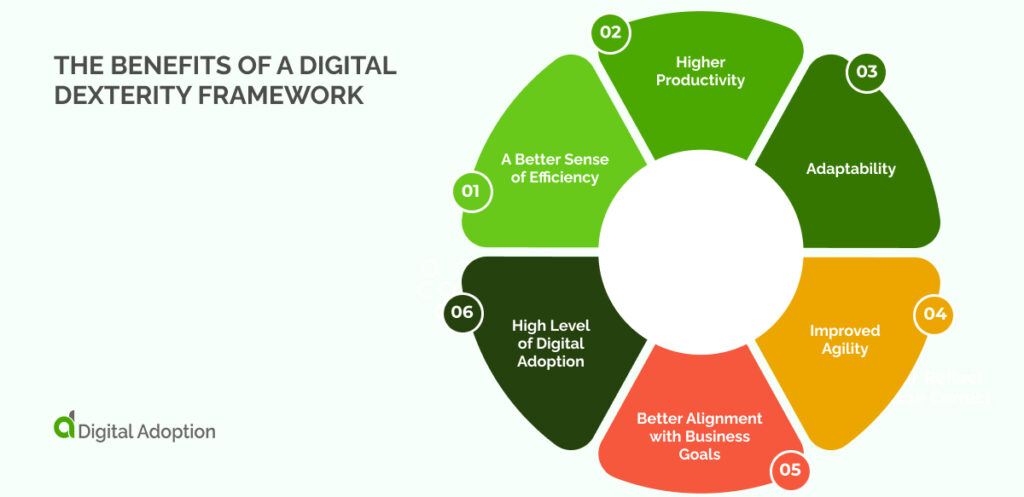
Despite the initial time and financial commitment, creating a plan that improves a workforce’s digital dexterity can significantly boost a company’s profitability, offering excellent return on investment (ROI).
Following this, there are numerous other advantages:
A Better Sense of Efficiency
Digital dexterity allows employees to finish tasks faster as automation takes over routine activities. This frees up time for other essential tasks, increasing overall efficiency.
Higher Productivity
Leveraging technology enables employees to achieve more in less time. This can lead to increased engagement and reduce the risk of burnout, as employees feel more accomplished and less overwhelmed.
Adaptability
A digitally dexterous workforce is well-prepared to adopt new technologies as they emerge. Even if there’s an initial technology adoption curve, employees are willing to learn and improve, keeping the organization at the forefront of technological changes.
Improved Agility
While increasing productivity and efficiency is important, it doesn’t automatically translate to better quality. However, an agile workforce, adept in using digital tools, can quickly adapt and make necessary adjustments to enhance the quality of their work.
Better Alignment with Business Goals
Digital dexterity aligns closely with streamlined business objectives. Training in digital skills enables employees to improve customer service, prepare for digital disruptions, and adapt to cultural changes influenced by consumer technology.
High Level of Digital Adoption
Given the substantial investment in digital transformation projects, achieving widespread adoption of new digital applications and processes is crucial. Workforces with high digital dexterity are more likely to embrace these initiatives, demonstrating higher levels of adoption and less resistance to change.
In summary, fostering digital dexterity in the workforce augments immediate operational efficiency and productivity and positions the company to adapt more seamlessly to future technological shifts, aligning with long-term strategic goals.
Why Do Some Businesses Lack Digital Dexterity?
A digital transformation journey’s success or failure within companies often hinges on digital dexterity.
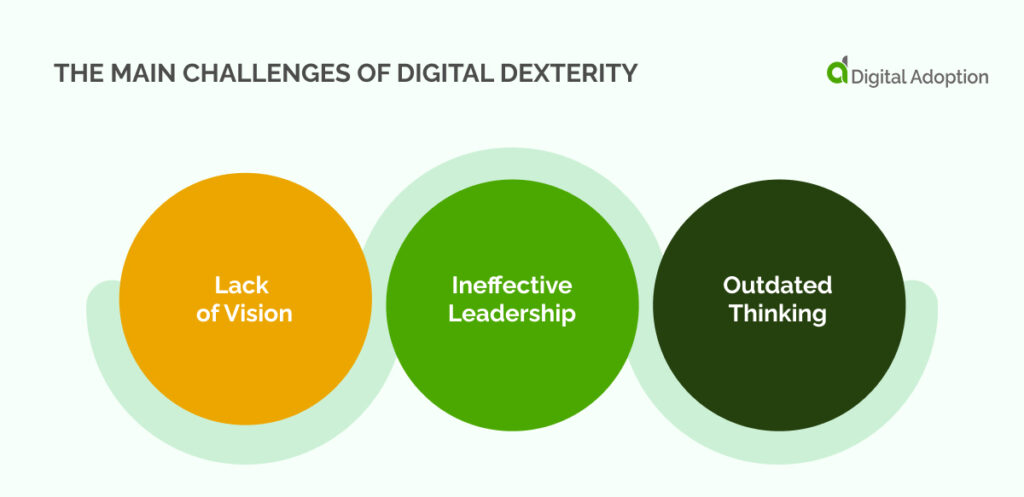
These are the main challenges of digital dexterity that some companies face:
Lack of Vision
For successful digital transformation, there must be a clear mission and vision guiding technological efforts. Companies need to identify specific problems and strategize their approach. Digital transformation transcends mere software upgrades; it encompasses revamping processes.
Setting and reflecting on digital milestones, like implementing new programs or process efficiency improvements, is crucial. Measuring success should involve assessing the ROI of digital updates and the reduction in work hours post-implementation. This approach enhances digital dexterity by providing employees with clear objectives for adopting new technologies.
Ineffective Leadership
A common obstacle is needing more definitive leadership in digital initiatives or having too many leaders without clear roles. For digital efforts to be successful, business leaders must fully endorse and actively promote a shift in the corporate culture.
It is important to have designated individuals accountable for overseeing each digital initiative.
Outdated Thinking
Innovation demands a shift in mindset. Companies that resist adopting new technologies risk becoming obsolete, much like the fates of Blockbuster. An employee’s reluctance to embrace change often stems from a need for more understanding or fear.
Overcoming these barriers involves educating and empowering employees about the benefits of technology in their work. This approach helps shift perspectives and embrace new, more efficient working methods.
Addressing these key areas can significantly impact a business’s ability to adapt to and thrive in a digitally evolving landscape.
Start Building A Digital Dexterity Framework For Your Employees
Incorporating digital dexterity into the core skill set of employees is a strategic move for companies aiming to enhance efficiency, boost productivity, and improve collaboration. Not only does it benefit the organization as a whole, but it also aids in individual employee development.
Establishing a digital dexterity framework allows organizations to equip their workforce with essential digital skills and foster a readiness to adapt to the rapidly changing digital environment.
This framework’s creation and successful implementation depend on robust leadership and dedicated support. HR departments should spearhead this initiative while team leaders focus on addressing the specific needs of individual employees.
Effective implementation of a digital dexterity framework involves mentorship, clear communication, and, crucially, streamlined employee onboarding software processes. Ensuring that digital tools are user-friendly and accessible is key to maximizing their value and utility within the organization.

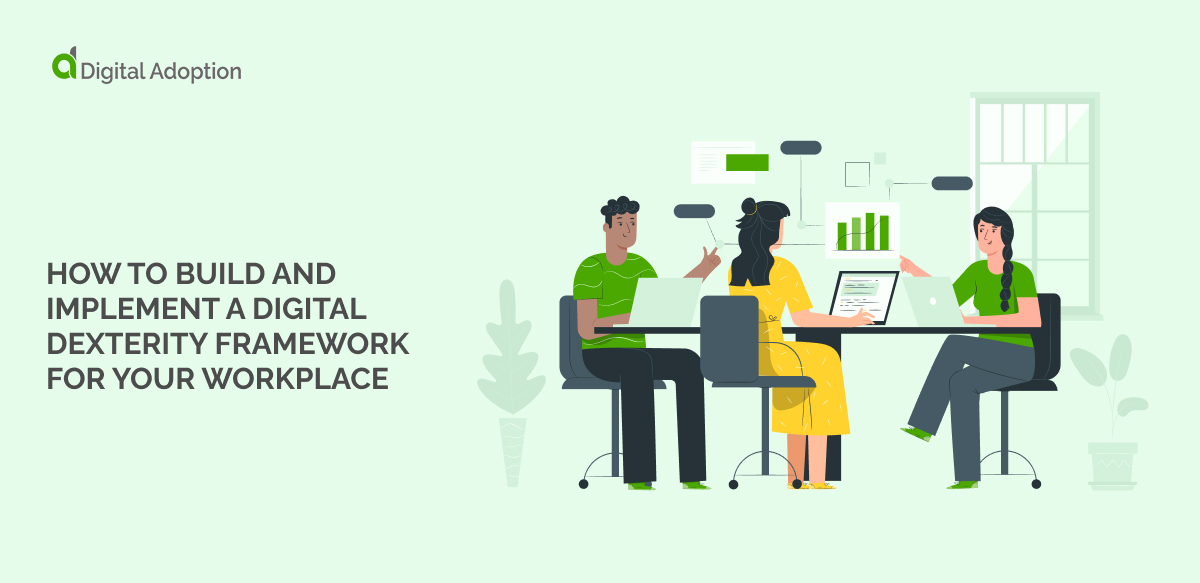


![18 Examples of AI in Finance [2025]](https://www.digital-adoption.com/wp-content/uploads/2025/06/18-Examples-of-AI-in-Finance-2025-300x146.jpg)
![14 Examples of AI in Manufacturing [2025]](https://www.digital-adoption.com/wp-content/uploads/2025/06/14-Examples-of-AI-in-Manufacturing-2025-300x146.jpg)
![29 Examples of AI in Education [2025]](https://www.digital-adoption.com/wp-content/uploads/2025/06/29-Examples-of-AI-in-Education-2025-300x146.jpg)
![15 Examples of AI in Retail [2025]](https://www.digital-adoption.com/wp-content/uploads/2025/06/15-Examples-of-AI-in-Retail-2025-300x146.jpg)
![13 Examples of AI in Healthcare [2025]](https://www.digital-adoption.com/wp-content/uploads/2025/06/AI-in-healthcare-examples-300x146.jpg)


![18 Examples of AI in Finance [2025]](https://www.digital-adoption.com/wp-content/uploads/2025/06/18-Examples-of-AI-in-Finance-2025.jpg)
![14 Examples of AI in Manufacturing [2025]](https://www.digital-adoption.com/wp-content/uploads/2025/06/14-Examples-of-AI-in-Manufacturing-2025.jpg)
![29 Examples of AI in Education [2025]](https://www.digital-adoption.com/wp-content/uploads/2025/06/29-Examples-of-AI-in-Education-2025.jpg)